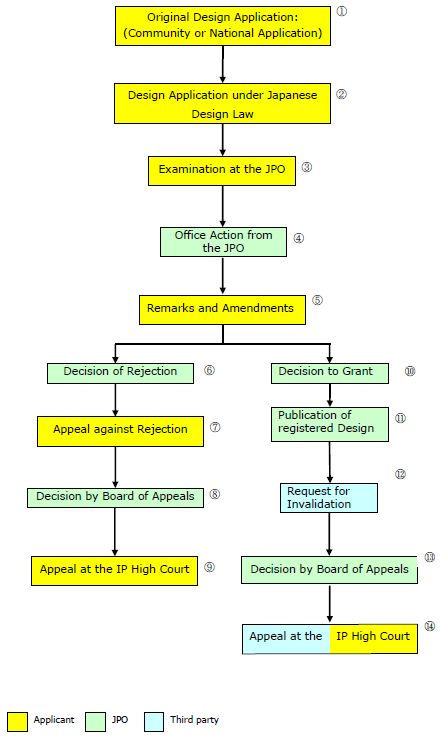
1. The original design application must be a national design application filed in one of the member countries of the Paris Convention or a regional application such as a Community Design application.
2. Japanese Design application may be filed claiming Priority within 6 months from the first application, and unique provisions under the Japanese Design law include:
- A design application must contain only one design (multiple designs cannot be filed in one application)
- For multiple articles in a set, such as a set of knives, forks, or spoons, a design can be filed in one application.
- More than one appearance of an article can be registered if the article changes shape (ex, clam shell cell phone)
- Similar designs can be filed by the same applicant before the first design is registered and published.
- Confidentiality can be requested for up to three years from the date of registration
- The design of a portion of a complex article, including icons to be displayed on a screen, can be registered
- There is a grace period of 6 months from the loss of novelty if the design was published while having the right to apply for a design protection or against the intention of the same person
3. Examinations begin without a request for examination and the examination is performed by one examiner.
4. Office Actions are issued if the design falls into one of the categories below:
- Those which are offensive to public order and morality;
- those which have a potential to create confusion with a third party's products;
- those which consists only of the shape which is indispensable to achieve its function;
- those known to the public; or
- those published in print or on the internet anywhere in the world;
- those which are similar to the above;
- those which could have been made easily by those skilled in the art based on designs known to the public before the filing date; and
- those which are identical or similar to the design which had been filed earlier and published after the filing date of the application, unless the two applications are filed by the same applicant.
5. The amendments should not change the essence of the design. An appeal may be filed against the decision to reject the amendments. When amendments are rejected as having changed the essence of the design, the applicant may file a new design application within 30 days from the rejection so that the filing date of the rejected amendment is deemed to be the filing date of the new application.
6. An appeal may be filed at the Board of Appeals.
7. A Board of Appeals consists of three appeal examiners.
8. An appeal may be filed at the IP High Court.
9. A body of three judges examines the legality/illegality of the procedure and the grounds for decision.
10. The owner of a registered design is provided with an exclusive right to exploit (make, use, sell, rent, offer for sale or rent, export, import) the registered design and the designs similar to the registered design. The design right can be valid for 20 years from the date of registration on the condition that annuities are paid in a timely manner.
11. Registered designs are published sometime after the registration, although the exclusive right of the design starts from the date of registration. Once a registered design is published, it becomes impossible to file an application for a design similar to the registered design.
12. A request for invalidation may be filed any time after the registration of a design, even after the expiration of the design registration.
13. Trials for Invalidation are an inter parte procedure before the Board of Appeals consisting of three appeal examiners.
14. A body of three judges examines the legality/illegality of the procedure and the grounds for the decision.
The content of this article is intended to provide a general guide to the subject matter. Specialist advice should be sought about your specific circumstances.
